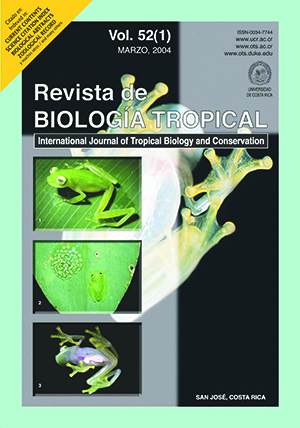Resumen
Los euglenoides son eucariotas unicelulares flagelados que habitan ambientes acuáticos y suelos de una gran diversidad de ecosistemas. Este trabajo presenta la descripción morfológica ultraestructural del euglenoide E. pailasensis aislado de las fuentes de lodo caliente de las “pailas de barro” en el Volcán Rincón de la Vieja, Guanacaste, Costa Rica. La temperatura de estos sitios puede variar entre 38 y 98° C y puede tener un pH entre 1 y 4. El estudio se realizó utilizando microscopia electrónica de barrido y transmisión. El euglenoide está constituido por una célula típica que puede medir de 30 a 45 μm de largo y 8-10 μm de ancho, con membrana externa, película, cloroplastos, mitocondrias, núcleo, pigmentos granulares y demás organelas citoplasmáticas de un eucarionte. Esta delimitado por una membrana continua y por una película compuesta de aproximadamente 40 - 90 mionemas que miden entre 0.8 y 1.0 μm de ancho, dispuestas helicoidalmente sobre la célula. Se observó 5 cloroplastos elongados por célula, de 1-2 μm de diámetro y 6-12 μm de largo, delimitados por tres membranas y localizados en la periferia celular. Este posee glóbulos osmiofílicos y un pirenoide penetrado por pocos tilacoides. El material nutritivo se almacena en gránulos de paramilón y las mitocondrias presentan las crestas en disposición radial hacia el interior del lumen. La zona de la ámpula se observó sin flagelo y se notó una red de fibrillas que envuelve el espécimen. Las características ultraestructurales observadas en este estudio, no permiten explicar la capacidad de E. pailasensis para habitar en el ambiente volcánico extremo de las Pailas de Barro Caliente.Citas
Adachi, E. 1999. Gallium replication in aquatic and nonaquatic organism scanning electron microscopy. Ultramicroscopy 80: 51-58.
Arnott, H.J. & M.A. Farmer. 2000. Comparative morphology of the euglenid oellicle. I. Patterns of strips and pores. J. Eukaryot. Microbiol. 47: 469-479.
Brock, T.D. 1986. Introducction: An overview of the thermophiles. pp. 1-16. In: Brock T. D.(eds). Termophiles, general, molecular and applied microbiology. John Wiley & Sons, New York.
Dubreuil, R.R. & G.B. Bouck. 1985. The membrane skeleton of a unicellular organism consists of bridged, articulating strips. J. Cell. Biol. 101: 1884-1896.
Kapfer, M. 1998. Assessment of the colonization and primary production of microphytobenthos in the littoral of acidic mining lakes in Lusatia (Germany). Wat. Air Soil Pollut. 108: 331-340.
Kempner, E.S. & A.G. Marr. 1970. Growth in volume of Euglena gracilis during the division cycle. J. Bacteriol.101: 561-567.
Leedale, G.F. 1964. Pellicle structure in Euglena . Brit. Phycol. Bull 2: 291-306.
Leedale, G.F., J.D. Meeuse & E.G. Pringsheim. 1965. Structure and physiology of Euglena spirogyra. I and II. Arch. für Mikrobiol. 50: 68-102.
Leedale, G.F. 1967. Euglenoid Flagellates. Prentice-Hall. Inc. Englewoud Clifs, N.J. U.S.A. p. 137-192.
Lefort-Tran, M., M.H. Bre, J.L. Ranck & M. Pouphile. 1980. Euglena plasma membrane during normal and vitamin B12 starvation growth. J. Cell. Sci. 41: 245- 261.
Lessman, D., R. Deneke, R. Ender, M. Hemm, M. Kapfer, H. Krumbeck, K. Wollmamm & B. Nixdorf. 1999. Lake Plessa 107 (Lusatia, Germany) - an extremely acidic shallow mining lake. Hidrobiol. 408/409: 293- 299.
Lowy, J. & J. Hanson. 1965. Electron microscope studies of bacterial flagella. J. Mol. Biol. 11: 293-313.
Mermelstein, C.S., A. P. Rodríguez, M. Einicker-Lamas, R.E. de B. Navarrete, M. Farina & M.L. Costa. 1998. Distribution of F-actin, a-actinin, tropomyosin, tubulin and organelles in Euglena gracilis by inmunofluorescence microscopy. Tissue & Cell 30: 545-553.
Müllner A. N., D. G. Angeler, R. Samuel, E. W. Linton & R. E. Triemer. 2001. Phylogenetic analysis of phagotropic, phototrophic and osmotrophic euglenoids by using the nuclear 18 sDNA sequence. Int. J. Syst. Evol. Microb. 51: 783-791.
Murray, J.M. 1981. Control of cell shape by calciumin the Euglenophyceae. J. Cell. Sci. 49: 99-117.
Osafune, T., S. Sumida, E., T. Ehara, N. Ueno, E. Hase & J.A. Schiff. 1990. Lipid (wax) and paramylum as sources of carbon and energy for the early development of proplastidas in dark-grown Euglena gracilis cells transferred to an inorganic medium. J. Electron. Microsc. 39: 372-381.
Pringsheim, E.G. 1948. Taxonomic problems in the Euglenineae. Biol. Rev. 23: 46-61.
Pringsheim, E.G. 1956. Contribution towards a monograph of the genus Euglena. Nova Acta Leopoldina 18: 1- 168.
Schwartzbach, S.D., J.A. Schiff & N. Goldstein. 1975. Events surrounding the early development of Euglena chloroplasts. Control of paramylum degradation. Plant Physiol. 56: 313-317.
Sittenfeld, A., M. Mora, J.M. Ortega, F. Albertazzi, A. Cordero, M. Roncel, E. Sánchez, M. Vargas, M.
Fernández, J. Weckesser & A. Serrano. 2002. Characterization of a photosynthetic Euglena strain isolated from an acidic hot mud pool of a volcanic area of Costa Rica. FEMS Microbiol. Ecol. 42: 151-161.
Sittenfeld, A., M. Vargas, E. Sánchez, M. Mora & A. Serrano. 2004. Una nueva especie de Euglena (Euglenozoa: Euglenales) aislada de ambientes extremófilos en las Pailas de Barro del Volcán Rincón de la Vieja, Costa Rica. Rev. Biol. Trop. 52: 27-30.
Sueoka, N., K.S. Chiang & J.R. Kates. 1967. Deoxiribonucleic acid and replication in meiosis of Chlamydomonas reinhardtii. Isotipic transfer experiments with a strain producing eight zoospores. J. Mol. Biol. 25: 47-66.
Summer, J.R. 1965. The ultrastructure of the pellicle complex of Euglena gracilis. J. Cell. Biol. 24: 253 257.
Van den Hoek, C., D.G. Mann & H.M. Jahns. 1993. Algae: An introduction to phycology. Cambridge University, Cambridge. 627 p.
Vismara R., L. Barsanti, P. Lupetti, V. Passarelli, D. Mercati, F. Dallai & P. Gualtieri. 2000. Ultrastructure of the pellicle of Euglena gracilis. Tissue & Cell 32: 451-456.
Walsh M. M. & J. Seckbach. 1999. The versatility of microorganisms. p. 153-162. In: Seckbach (eds.). Microorganisms and life in extreme environments. J. Kluver Academic Publishers, Netherlands.
Wen J. 2000. The nuclear matrix of Euglena gracilis (Euglenophyta): A stage of nuclear matrix evolution?
Biol. Cell. 92: 125-131.
Zakrys B., J. Cambra-Sanchez & P.L. Walne. 2001. Chloroplast ultrastructure of Euglena cuneata Pringsheim, E. deses Ehrenberg and E. mutabilis (Euglenophyceae): Taxonomic significance. Acta Protozool. 40: 161-167.
##plugins.facebook.comentarios##

Esta obra está bajo una licencia internacional Creative Commons Atribución 4.0.
Derechos de autor 2004 Revista de Biología Tropical


